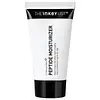What's inside
What's inside
 Key Ingredients
Key Ingredients

 Benefits
Benefits

 Concerns
Concerns

 Ingredients Side-by-side
Ingredients Side-by-side

Water
Skin ConditioningCaprylic/Capric Triglyceride
MaskingGlycerin
HumectantC12-15 Alkyl Benzoate
AntimicrobialCetearyl Alcohol
EmollientGlyceryl Stearate Se
EmulsifyingBetaine
HumectantButylene Glycol
HumectantPhenoxyethanol
PreservativeBenzyl Alcohol
PerfumingCarbomer
Emulsion StabilisingButyrospermum Parkii Butter
Skin ConditioningSodium Stearoyl Glutamate
CleansingSodium Hydroxide
BufferingEthylhexylglycerin
Skin ConditioningSodium Gluconate
Skin ConditioningTocopheryl Acetate
AntioxidantDehydroacetic Acid
PreservativeHydrogenated Lecithin
EmulsifyingPhenethyl Alcohol
MaskingAcetyl Hexapeptide-37
Skin ConditioningMaltodextrin
AbsorbentPentapeptide-48
Skin ConditioningWater, Caprylic/Capric Triglyceride, Glycerin, C12-15 Alkyl Benzoate, Cetearyl Alcohol, Glyceryl Stearate Se, Betaine, Butylene Glycol, Phenoxyethanol, Benzyl Alcohol, Carbomer, Butyrospermum Parkii Butter, Sodium Stearoyl Glutamate, Sodium Hydroxide, Ethylhexylglycerin, Sodium Gluconate, Tocopheryl Acetate, Dehydroacetic Acid, Hydrogenated Lecithin, Phenethyl Alcohol, Acetyl Hexapeptide-37, Maltodextrin, Pentapeptide-48
Water
Skin ConditioningCitrullus Lanatus Seed Oil
EmollientSqualane
EmollientTriolein
Skin ConditioningMusa Sapientum Leaf Extract
Skin ConditioningGlycerin
HumectantBetaine
HumectantCetearyl Olivate
Butyrospermum Parkii Butter
Skin ConditioningCrambe Abyssinica Seed Oil Phytosterol Esters
EmulsifyingGlyceryl Stearate Se
EmulsifyingJojoba Esters
EmollientSelaginella Lepidophylla Extract
EmollientCetearyl Alcohol
EmollientCetyl Palmitate
EmollientSorbitan Olivate
EmulsifyingNicotiana Benthamiana Hexapeptide-40 Sh-Polypeptide-76
Skin ConditioningButylene Glycol
HumectantSalix Alba Bark Extract
AstringentGenipa Americana Fruit Extract
Skin ConditioningSorbitan Palmitate
EmulsifyingSorbitan Oleate
EmulsifyingXanthan Gum
EmulsifyingCitric Acid
BufferingWater, Citrullus Lanatus Seed Oil, Squalane, Triolein, Musa Sapientum Leaf Extract, Glycerin, Betaine, Cetearyl Olivate, Butyrospermum Parkii Butter, Crambe Abyssinica Seed Oil Phytosterol Esters, Glyceryl Stearate Se, Jojoba Esters, Selaginella Lepidophylla Extract, Cetearyl Alcohol, Cetyl Palmitate, Sorbitan Olivate, Nicotiana Benthamiana Hexapeptide-40 Sh-Polypeptide-76, Butylene Glycol, Salix Alba Bark Extract, Genipa Americana Fruit Extract, Sorbitan Palmitate, Sorbitan Oleate, Xanthan Gum, Citric Acid
 Reviews
Reviews

Ingredients Explained
These ingredients are found in both products.
Ingredients higher up in an ingredient list are typically present in a larger amount.
Betaine is a common humectant (a substance that promotes retention of moisture). It's known to be gentle on the skin and can help balance hydration.
This ingredient is best for improving hydration and soothing irritated skin. Studies also show it helps even out skin tone.
Fun fact: Betaine is naturally created in the skin and body. The kind found within cosmetic products can be either plant-derived or synthetic.
Another name for betaine is trimethylglycine.
Learn more about BetaineButylene Glycol (or BG) is used within cosmetic products for a few different reasons:
Overall, Butylene Glycol is a safe and well-rounded ingredient that works well with other ingredients.
Though this ingredient works well with most skin types, some people with sensitive skin may experience a reaction such as allergic rashes, closed comedones, or itchiness.
Learn more about Butylene GlycolThis ingredient is also known as shea butter. It is an effective skin hydrator and emollient.
Emollients help soothe and soften your skin. It does this by creating a protective film on your skin. This barrier helps trap moisture and keeps your skin hydrated. Emollients may be effective at treating dry or itchy skin.
Shea butter is rich in antioxidants. Antioxidants help fight free-radicals, or molecules that may harm the body. It is also full of fatty acids including stearic acid and linoleic acid. These acids help replenish the skin and keep skin moisturized.
While Shea Butter has an SPF rating of about 3-4, it is not a sunscreen replacement.
Shea butter may not be fungal acne safe. We recommend speaking with a professional if you have any concerns.
Learn more about Butyrospermum Parkii ButterCetearyl alcohol is a mixture of two fatty alcohols: cetyl alcohol and stearyl alcohol. It is mainly used as an emulsifier. Emulsifiers help prevent the separation of oils and products. Due to its composition, it can also be used to thicken a product or help create foam.
Cetearyl alcohol is an emollient. Emollients help soothe and hydrate the skin by trapping moisture.
Studies show Cetearyl alcohol is non-toxic and non-irritating. The FDA allows products labeled "alcohol-free" to have fatty alcohols.
This ingredient is usually derived from plant oils such as palm, vegetable, or coconut oils. There is debate on whether this ingredient will cause acne.
Due to the fatty acid base, this ingredient may not be Malassezia folliculitis safe.
Learn more about Cetearyl AlcoholGlycerin is already naturally found in your skin. It helps moisturize and protect your skin.
A study from 2016 found glycerin to be more effective as a humectant than AHAs and hyaluronic acid.
As a humectant, it helps the skin stay hydrated by pulling moisture to your skin. The low molecular weight of glycerin allows it to pull moisture into the deeper layers of your skin.
Hydrated skin improves your skin barrier; Your skin barrier helps protect against irritants and bacteria.
Glycerin has also been found to have antimicrobial and antiviral properties. Due to these properties, glycerin is often used in wound and burn treatments.
In cosmetics, glycerin is usually derived from plants such as soybean or palm. However, it can also be sourced from animals, such as tallow or animal fat.
This ingredient is organic, colorless, odorless, and non-toxic.
Glycerin is the name for this ingredient in American English. British English uses Glycerol/Glycerine.
Learn more about GlycerinGlyceryl Stearate Se is a self-emulsifying (SE) form of glyceryl stearate. Self-emusifying means this ingredient automatically blends with water. It is an emulsifier, emollient, and cleansing agent.
As an emulsifier, Glyceryl Stearate Se prevents ingredients such as oil and water from separating. It is also a surfactant, meaning it helps cleanse the skin. Surfactants help gather oil, dirt, and other pollutants so they may be rinsed away easily.
Emollients help your skin stay smooth and soft. It does so by creating a film on top of the skin that helps trap moisture in.
Learn more about Glyceryl Stearate SeWater. It's the most common cosmetic ingredient of all. You'll usually see it at the top of ingredient lists, meaning that it makes up the largest part of the product.
So why is it so popular? Water most often acts as a solvent - this means that it helps dissolve other ingredients into the formulation.
You'll also recognize water as that liquid we all need to stay alive. If you see this, drink a glass of water. Stay hydrated!
Learn more about Water